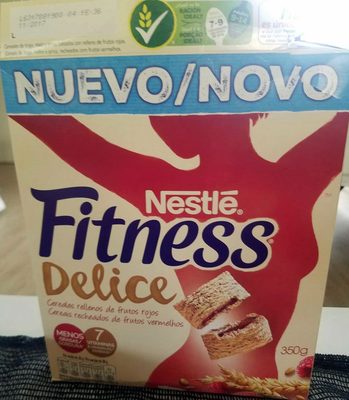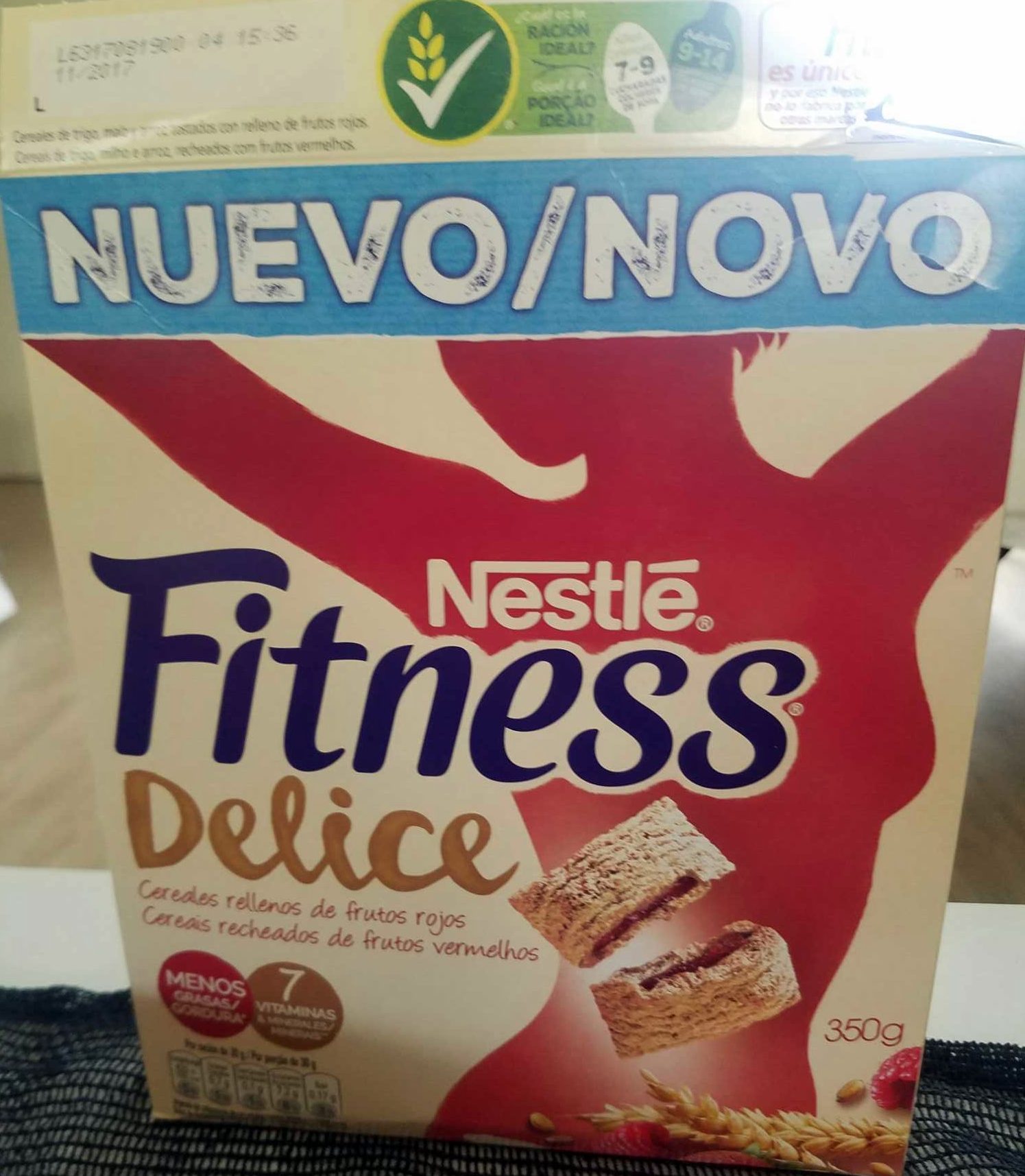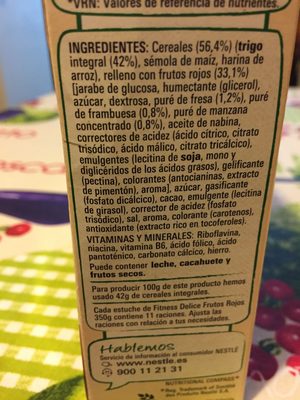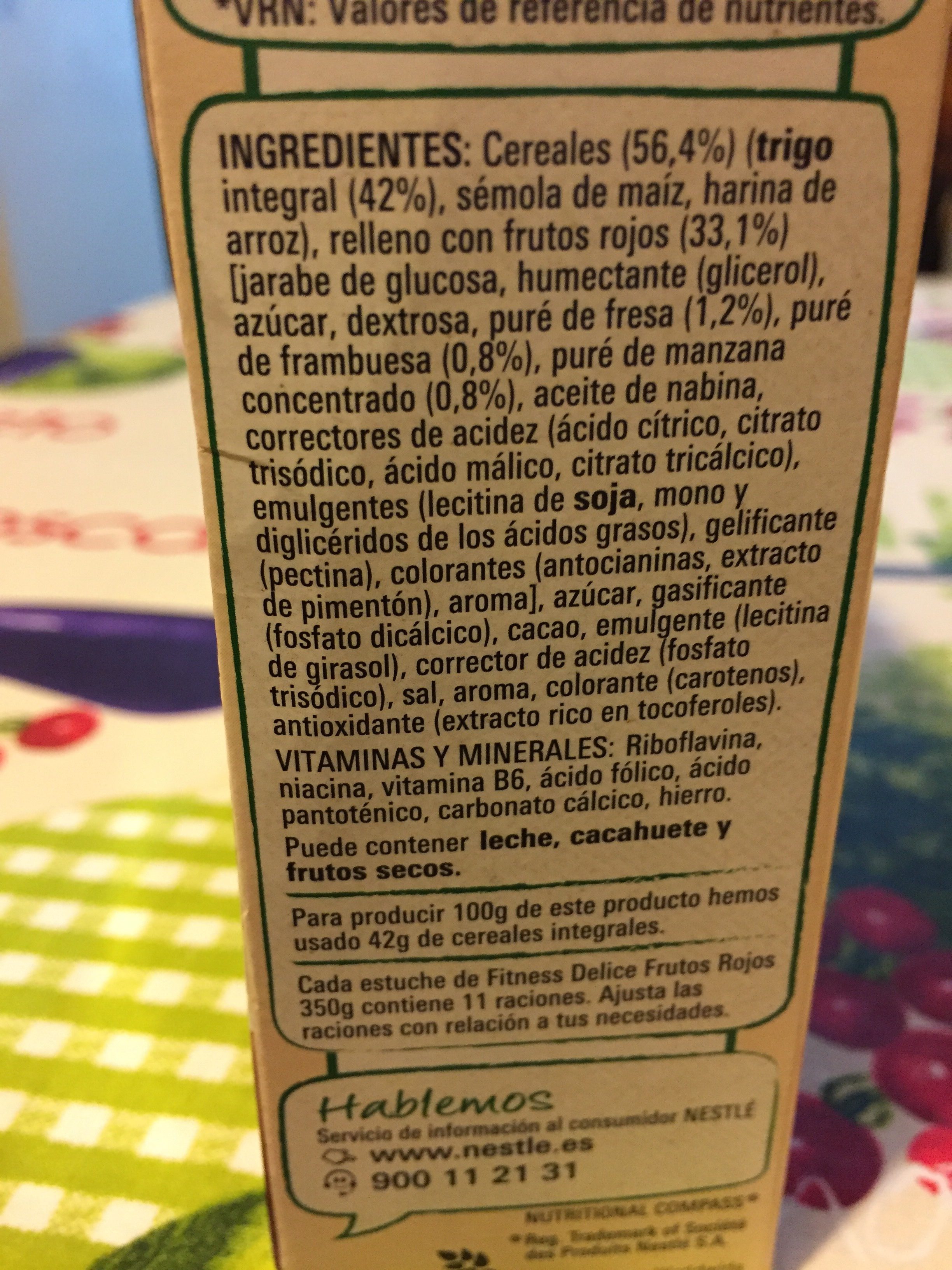Help us make food transparency the norm!
As a non-profit organization, we depend on your donations to continue informing consumers around the world about what they eat.
The food revolution starts with you!
Fitness Delice frutos rojos - Nestlé - 350 g
Fitness Delice frutos rojos - Nestlé - 350 g
This product page is not complete. You can help to complete it by editing it and adding more data from the photos we have, or by taking more photos using the app for Android or iPhone/iPad. Thank you!
×
Barcode: 7613035613843 (EAN / EAN-13)
Quantity: 350 g
Packaging: Plastic, Bag, Box, Container
Brands: Nestlé
Categories: Plant-based foods and beverages, Plant-based foods, Breakfasts, Cereals and potatoes, Cereals and their products, Breakfast cereals, Extruded cereals, Filled cereals
Countries where sold: Spain
Matching with your preferences
Health
Ingredients
-
52 ingredients
: Cereales (56,4 %) (trigo integral (42 %), sémola de maiz, harina de arroz), relleno con frutos rojos (33,1 %, [jarabe de glucosa, humectante (glicerol), azûcar, dextrosa, puré de fresa (1,2 %), puré de frambuesa (0,8 %), puré de manzana concentrado (0,8%), aceite de nabina, correctores de acidez (acido citrico, citrato trisodico, acido mâlico, citrato tricalcico), emulgentes (lecitina de soja, mono y diglicéridos de los acidos grasos), gelificante ( lecitina), colorantes (antocianinas, extracto de pimenton), aroma, azücar, gasificante (fosfato dicalcico), cacao, emulgente (lecitina de girasol), corrector de acidez (fosfato trisodico), sal, aroma, colorante (carotenos), antioxidante (extracto rico en tocoferoles). vitaminas y minerales: Riboflavina, niacina, vitamina B6, acido folico, acido pantoténico, carbonato calcico, hierro.Allergens: Gluten, SoybeansTraces: Milk, Nuts, Peanuts
Food processing
-
Ultra processed foods
Elements that indicate the product is in the 4 - Ultra processed food and drink products group:
- Additive: E160c - Paprika extract
- Additive: E163 - Anthocyanins
- Additive: E322 - Lecithins
- Additive: E422 - Glycerol
- Additive: E471 - Mono- and diglycerides of fatty acids
- Ingredient: Colour
- Ingredient: Dextrose
- Ingredient: Emulsifier
- Ingredient: Flavouring
- Ingredient: Gelling agent
- Ingredient: Glucose
- Ingredient: Glucose syrup
- Ingredient: Humectant
Food products are classified into 4 groups according to their degree of processing:
- Unprocessed or minimally processed foods
- Processed culinary ingredients
- Processed foods
- Ultra processed foods
The determination of the group is based on the category of the product and on the ingredients it contains.
Additives
-
E163 - Anthocyanins
Anthocyanin: Anthocyanins -also anthocyans; from Greek: ἄνθος -anthos- "flower" and κυάνεος/κυανοῦς kyaneos/kyanous "dark blue"- are water-soluble vacuolar pigments that, depending on their pH, may appear red, purple, or blue. Food plants rich in anthocyanins include the blueberry, raspberry, black rice, and black soybean, among many others that are red, blue, purple, or black. Some of the colors of autumn leaves are derived from anthocyanins.Anthocyanins belong to a parent class of molecules called flavonoids synthesized via the phenylpropanoid pathway. They occur in all tissues of higher plants, including leaves, stems, roots, flowers, and fruits. Anthocyanins are derived from anthocyanidins by adding sugars. They are odorless and moderately astringent. Although approved to color foods and beverages in the European Union, anthocyanins are not approved for use as a food additive because they have not been verified as safe when used as food or supplement ingredients. There is no conclusive evidence anthocyanins have any effect on human biology or diseases.Source: Wikipedia
-
E296 - Malic acid
Malic acid: Malic acid is an organic compound with the molecular formula C4H6O5. It is a dicarboxylic acid that is made by all living organisms, contributes to the pleasantly sour taste of fruits, and is used as a food additive. Malic acid has two stereoisomeric forms -L- and D-enantiomers-, though only the L-isomer exists naturally. The salts and esters of malic acid are known as malates. The malate anion is an intermediate in the citric acid cycle.Source: Wikipedia
-
E322 - Lecithins
Lecithins are natural compounds commonly used in the food industry as emulsifiers and stabilizers.
Extracted from sources like soybeans and eggs, lecithins consist of phospholipids that enhance the mixing of oil and water, ensuring smooth textures in various products like chocolates, dressings, and baked goods.
They do not present any known health risks.
-
E322i - Lecithin
Lecithins are natural compounds commonly used in the food industry as emulsifiers and stabilizers.
Extracted from sources like soybeans and eggs, lecithins consist of phospholipids that enhance the mixing of oil and water, ensuring smooth textures in various products like chocolates, dressings, and baked goods.
They do not present any known health risks.
-
E330 - Citric acid
Citric acid is a natural organic acid found in citrus fruits such as lemons, oranges, and limes.
It is widely used in the food industry as a flavor enhancer, acidulant, and preservative due to its tart and refreshing taste.
Citric acid is safe for consumption when used in moderation and is considered a generally recognized as safe (GRAS) food additive by regulatory agencies worldwide.
-
E331 - Sodium citrates
Sodium citrate: Sodium citrate may refer to any of the sodium salts of citrate -though most commonly the third-: Monosodium citrate Disodium citrate Trisodium citrateThe three forms of the salt are collectively known by the E number E331. Sodium citrates are used as acidity regulators in food and drinks, and also as emulsifiers for oils. They enable cheeses to melt without becoming greasy.Source: Wikipedia
-
E331iii - Trisodium citrate
Sodium citrate: Sodium citrate may refer to any of the sodium salts of citrate -though most commonly the third-: Monosodium citrate Disodium citrate Trisodium citrateThe three forms of the salt are collectively known by the E number E331. Sodium citrates are used as acidity regulators in food and drinks, and also as emulsifiers for oils. They enable cheeses to melt without becoming greasy.Source: Wikipedia
-
E333 - Calcium citrates
Calcium citrate: Calcium citrate is the calcium salt of citric acid. It is commonly used as a food additive -E333-, usually as a preservative, but sometimes for flavor. In this sense, it is similar to sodium citrate. Calcium citrate is also found in some dietary calcium supplements -e.g. Citracal-. Calcium makes up 24.1% of calcium citrate -anhydrous- and 21.1% of calcium citrate -tetrahydrate- by mass. The tetrahydrate occurs in nature as the mineral Earlandite.Source: Wikipedia
-
E333iii - Tricalcium citrate
Calcium citrate: Calcium citrate is the calcium salt of citric acid. It is commonly used as a food additive -E333-, usually as a preservative, but sometimes for flavor. In this sense, it is similar to sodium citrate. Calcium citrate is also found in some dietary calcium supplements -e.g. Citracal-. Calcium makes up 24.1% of calcium citrate -anhydrous- and 21.1% of calcium citrate -tetrahydrate- by mass. The tetrahydrate occurs in nature as the mineral Earlandite.Source: Wikipedia
-
E339 - Sodium phosphates
Sodium phosphates: Sodium phosphate is a generic term for a variety of salts of sodium -Na+- and phosphate -PO43−-. Phosphate also forms families or condensed anions including di-, tri-, tetra-, and polyphosphates. Most of these salts are known in both anhydrous -water-free- and hydrated forms. The hydrates are more common than the anhydrous forms.Source: Wikipedia
-
E339iii - Trisodium phosphate
Sodium phosphates: Sodium phosphate is a generic term for a variety of salts of sodium -Na+- and phosphate -PO43−-. Phosphate also forms families or condensed anions including di-, tri-, tetra-, and polyphosphates. Most of these salts are known in both anhydrous -water-free- and hydrated forms. The hydrates are more common than the anhydrous forms.Source: Wikipedia
-
E341 - Calcium phosphates
Calcium phosphate: Calcium phosphate is a family of materials and minerals containing calcium ions -Ca2+- together with inorganic phosphate anions. Some so-called calcium phosphates contain oxide and hydroxide as well. They are white solids of nutritious value.Source: Wikipedia
-
E341ii - Dicalcium phosphate
Calcium phosphate: Calcium phosphate is a family of materials and minerals containing calcium ions -Ca2+- together with inorganic phosphate anions. Some so-called calcium phosphates contain oxide and hydroxide as well. They are white solids of nutritious value.Source: Wikipedia
-
E422 - Glycerol
Glycerol: Glycerol -; also called glycerine or glycerin; see spelling differences- is a simple polyol compound. It is a colorless, odorless, viscous liquid that is sweet-tasting and non-toxic. The glycerol backbone is found in all lipids known as triglycerides. It is widely used in the food industry as a sweetener and humectant and in pharmaceutical formulations. Glycerol has three hydroxyl groups that are responsible for its solubility in water and its hygroscopic nature.Source: Wikipedia
-
E471 - Mono- and diglycerides of fatty acids
Mono- and diglycerides of fatty acids (E471), are food additives commonly used as emulsifiers in various processed foods.
These compounds consist of glycerol molecules linked to one or two fatty acid chains, which help stabilize and blend water and oil-based ingredients. E471 enhances the texture and shelf life of products like margarine, baked goods, and ice cream, ensuring a smooth and consistent texture.
It is generally considered safe for consumption within established regulatory limits.
Ingredients analysis
-
May contain palm oil
Ingredients that may contain palm oil: E471, E160a
-
Vegan status unknown
Unrecognized ingredients: es:relleno-con-frutos-rojos, Folic acid, IronSome ingredients could not be recognized.
We need your help!
You can help us recognize more ingredients and better analyze the list of ingredients for this product and others:
- Edit this product page to correct spelling mistakes in the ingredients list, and/or to remove ingredients in other languages and sentences that are not related to the ingredients.
- Add new entries, synonyms or translations to our multilingual lists of ingredients, ingredient processing methods, and labels.
If you would like to help, join the #ingredients channel on our Slack discussion space and/or learn about ingredients analysis on our wiki. Thank you!
-
Vegetarian status unknown
Unrecognized ingredients: es:relleno-con-frutos-rojos, Folic acid, IronSome ingredients could not be recognized.
We need your help!
You can help us recognize more ingredients and better analyze the list of ingredients for this product and others:
- Edit this product page to correct spelling mistakes in the ingredients list, and/or to remove ingredients in other languages and sentences that are not related to the ingredients.
- Add new entries, synonyms or translations to our multilingual lists of ingredients, ingredient processing methods, and labels.
If you would like to help, join the #ingredients channel on our Slack discussion space and/or learn about ingredients analysis on our wiki. Thank you!
-
Details of the analysis of the ingredients
We need your help!
Some ingredients could not be recognized.
We need your help!
You can help us recognize more ingredients and better analyze the list of ingredients for this product and others:
- Edit this product page to correct spelling mistakes in the ingredients list, and/or to remove ingredients in other languages and sentences that are not related to the ingredients.
- Add new entries, synonyms or translations to our multilingual lists of ingredients, ingredient processing methods, and labels.
If you would like to help, join the #ingredients channel on our Slack discussion space and/or learn about ingredients analysis on our wiki. Thank you!
: Cereales 56.4% (_trigo_ integral 42%, sémola de maiz, harina de arroz), relleno con frutos rojos 33.1%, jarabe de glucosa, humectante (glicerol), azûcar, dextrosa, puré de fresa 1.2%, puré de frambuesa 0.8%, manzana 0.8%, aceite de nabina, correctores de acidez (acido citrico, citrato trisodico, acido mâlico, citrato tricalcico), emulgentes (lecitina de _soja_, mono- y diglicéridos de los acidos grasos), gelificante (lecitina), colorantes (antocianinas, extracto de pimenton), aroma, azücar, gasificante (fosfato dicalcico), cacao, emulgente (lecitina de girasol), corrector de acidez (fosfato trisodico), sal, aroma, colorante (carotenos), antioxidante (extracto rico en tocoferoles), vitaminas, minerales (Riboflavina), niacina, vitaminas, vitamina B6, acido folico, acido pantoténico, carbonato calcico, hierro- Cereales -> en:cereal - vegan: yes - vegetarian: yes - percent_min: 56.4 - percent: 56.4 - percent_max: 56.4
- _trigo_ integral -> en:whole-wheat - vegan: yes - vegetarian: yes - ciqual_food_code: 9010 - percent_min: 42 - percent: 42 - percent_max: 42
- sémola de maiz -> en:cornmeal - vegan: yes - vegetarian: yes - ciqual_food_code: 9615 - percent_min: 7.2 - percent_max: 14.4
- harina de arroz -> en:rice-flour - vegan: yes - vegetarian: yes - ciqual_food_code: 9520 - percent_min: 0 - percent_max: 7.2
- relleno con frutos rojos -> es:relleno-con-frutos-rojos - percent_min: 33.1 - percent: 33.1 - percent_max: 33.1
- jarabe de glucosa -> en:glucose-syrup - vegan: yes - vegetarian: yes - ciqual_proxy_food_code: 31016 - percent_min: 1.2 - percent_max: 4.1
- humectante -> en:humectant - percent_min: 1.2 - percent_max: 4.1
- glicerol -> en:e422 - vegan: maybe - vegetarian: maybe - percent_min: 1.2 - percent_max: 4.1
- azûcar -> en:sugar - vegan: yes - vegetarian: yes - ciqual_proxy_food_code: 31016 - percent_min: 1.2 - percent_max: 3.1
- dextrosa -> en:dextrose - vegan: yes - vegetarian: yes - ciqual_proxy_food_code: 31016 - percent_min: 1.2 - percent_max: 2.025
- puré de fresa -> en:strawberry-puree - vegan: maybe - vegetarian: maybe - ciqual_food_code: 13014 - percent_min: 1.2 - percent: 1.2 - percent_max: 1.2
- puré de frambuesa -> en:raspberry-puree - vegan: maybe - vegetarian: maybe - ciqual_food_code: 13015 - percent_min: 0.8 - percent: 0.8 - percent_max: 0.8
- manzana -> en:apple - vegan: yes - vegetarian: yes - ciqual_food_code: 13050 - percent_min: 0.8 - percent: 0.8 - percent_max: 0.699999999999998
- aceite de nabina -> en:colza-oil - vegan: yes - vegetarian: yes - from_palm_oil: no - ciqual_food_code: 17130 - percent_min: 0 - percent_max: 0.512499999999999
- correctores de acidez -> en:acidity-regulator - percent_min: 0 - percent_max: 0.455555555555555
- acido citrico -> en:e330 - vegan: yes - vegetarian: yes - percent_min: 0 - percent_max: 0.455555555555555
- citrato trisodico -> en:e331iii - vegan: yes - vegetarian: yes - percent_min: 0 - percent_max: 0.227777777777777
- acido mâlico -> en:e296 - vegan: yes - vegetarian: yes - percent_min: 0 - percent_max: 0.151851851851852
- citrato tricalcico -> en:e333iii - vegan: yes - vegetarian: yes - percent_min: 0 - percent_max: 0.151851851851852
- emulgentes -> en:emulsifier - percent_min: 0 - percent_max: 0.409999999999999
- lecitina de _soja_ -> en:soya-lecithin - vegan: yes - vegetarian: yes - ciqual_food_code: 42200 - percent_min: 0 - percent_max: 0.409999999999999
- mono- y diglicéridos de los acidos grasos -> en:e471 - vegan: maybe - vegetarian: maybe - from_palm_oil: maybe - percent_min: 0 - percent_max: 0.205
- gelificante -> en:gelling-agent - percent_min: 0 - percent_max: 0.372727272727272
- lecitina -> en:e322i - vegan: maybe - vegetarian: maybe - percent_min: 0 - percent_max: 0.372727272727272
- colorantes -> en:colour - percent_min: 0 - percent_max: 0.341666666666666
- antocianinas -> en:e163 - vegan: yes - vegetarian: yes - percent_min: 0 - percent_max: 0.341666666666666
- extracto de pimenton -> en:e160c - vegan: yes - vegetarian: yes - percent_min: 0 - percent_max: 0.170833333333333
- aroma -> en:flavouring - vegan: maybe - vegetarian: maybe - percent_min: 0 - percent_max: 0.315384615384615
- azücar -> en:sugar - vegan: yes - vegetarian: yes - ciqual_proxy_food_code: 31016 - percent_min: 0 - percent_max: 0.292857142857142
- gasificante -> en:raising-agent - percent_min: 0 - percent_max: 0.273333333333333
- fosfato dicalcico -> en:e341ii - vegan: yes - vegetarian: yes - percent_min: 0 - percent_max: 0.273333333333333
- cacao -> en:cocoa - vegan: yes - vegetarian: yes - ciqual_proxy_food_code: 18100 - percent_min: 0 - percent_max: 0.273333333333333
- emulgente -> en:emulsifier - percent_min: 0 - percent_max: 0.273333333333333
- lecitina de girasol -> en:sunflower-lecithin - vegan: yes - vegetarian: yes - percent_min: 0 - percent_max: 0.273333333333333
- corrector de acidez -> en:acidity-regulator - percent_min: 0 - percent_max: 0.273333333333333
- fosfato trisodico -> en:e339iii - vegan: yes - vegetarian: yes - percent_min: 0 - percent_max: 0.273333333333333
- sal -> en:salt - vegan: yes - vegetarian: yes - ciqual_food_code: 11058 - percent_min: 0 - percent_max: 0.273333333333333
- aroma -> en:flavouring - vegan: maybe - vegetarian: maybe - percent_min: 0 - percent_max: 0.273333333333333
- colorante -> en:colour - percent_min: 0 - percent_max: 0.265
- carotenos -> en:e160a - vegan: maybe - vegetarian: maybe - from_palm_oil: maybe - percent_min: 0 - percent_max: 0.265
- antioxidante -> en:antioxidant - percent_min: 0 - percent_max: 0.252380952380952
- extracto rico en tocoferoles -> en:e306 - vegan: yes - vegetarian: yes - percent_min: 0 - percent_max: 0.252380952380952
- vitaminas -> en:vitamins - vegan: yes - vegetarian: yes - percent_min: 0 - percent_max: 0.240909090909091
- minerales -> en:minerals - percent_min: 0 - percent_max: 0.230434782608695
- Riboflavina -> en:e101 - vegan: maybe - vegetarian: yes - percent_min: 0 - percent_max: 0.230434782608695
- niacina -> en:e375 - vegan: maybe - vegetarian: maybe - percent_min: 0 - percent_max: 0.220833333333333
- vitaminas -> en:vitamins - vegan: yes - vegetarian: yes - percent_min: 0 - percent_max: 0.212
- vitamina B6 -> en:vitamin-b6 - vegan: yes - vegetarian: yes - percent_min: 0 - percent_max: 0.151851851851852
- acido folico -> en:folic-acid - percent_min: 0 - percent_max: 0.146428571428571
- acido pantoténico -> en:pantothenic-acid - vegan: yes - vegetarian: yes - percent_min: 0 - percent_max: 0.141379310344827
- carbonato calcico -> en:e170i - vegan: maybe - vegetarian: maybe - percent_min: 0 - percent_max: 0.141379310344827
- hierro -> en:iron - percent_min: 0 - percent_max: 0.132258064516129
Nutrition
-
Average nutritional quality
⚠ ️Warning: the amount of fruits, vegetables and nuts is not specified on the label, it was estimated from the list of ingredients: 2This product is not considered a beverage for the calculation of the Nutri-Score.
Positive points: 5
- Proteins: 3 / 5 (value: 6, rounded value: 6)
- Fiber: 5 / 5 (value: 5.2, rounded value: 5.2)
- Fruits, vegetables, nuts, and colza/walnut/olive oils: 0 / 5 (value: 2.8, rounded value: 2.8)
Negative points: 11
- Energy: 4 / 10 (value: 1381, rounded value: 1381)
- Sugars: 5 / 10 (value: 24, rounded value: 24)
- Saturated fat: 0 / 10 (value: 0.3, rounded value: 0.3)
- Sodium: 2 / 10 (value: 240, rounded value: 240)
The points for proteins are not counted because the negative points are greater or equal to 11.
Nutritional score: (11 - 5)
Nutri-Score:
-
Nutrient levels
-
Fat in low quantity (2.2%)
What you need to know- A high consumption of fat, especially saturated fats, can raise cholesterol, which increases the risk of heart diseases.
Recommendation: Limit the consumption of fat and saturated fat- Choose products with lower fat and saturated fat content.
-
Saturated fat in low quantity (0.3%)
What you need to know- A high consumption of fat, especially saturated fats, can raise cholesterol, which increases the risk of heart diseases.
Recommendation: Limit the consumption of fat and saturated fat- Choose products with lower fat and saturated fat content.
-
Sugars in high quantity (24%)
What you need to know- A high consumption of sugar can cause weight gain and tooth decay. It also augments the risk of type 2 diabetes and cardio-vascular diseases.
Recommendation: Limit the consumption of sugar and sugary drinks- Sugary drinks (such as sodas, fruit beverages, and fruit juices and nectars) should be limited as much as possible (no more than 1 glass a day).
- Choose products with lower sugar content and reduce the consumption of products with added sugars.
-
Salt in moderate quantity (0.6%)
What you need to know- A high consumption of salt (or sodium) can cause raised blood pressure, which can increase the risk of heart disease and stroke.
- Many people who have high blood pressure do not know it, as there are often no symptoms.
- Most people consume too much salt (on average 9 to 12 grams per day), around twice the recommended maximum level of intake.
Recommendation: Limit the consumption of salt and salted food- Reduce the quantity of salt used when cooking, and don't salt again at the table.
- Limit the consumption of salty snacks and choose products with lower salt content.
-
-
Nutrition facts
Nutrition facts As sold
for 100 g / 100 mlCompared to: Filled cereals Energy 1,381 kj
(330 kcal)-25% Fat 2.2 g -84% Saturated fat 0.3 g -92% Carbohydrates 24 g -65% Sugars 24 g -12% Fiber 5.2 g +8% Proteins 6 g -19% Salt 0.6 g -0% Fruits‚ vegetables‚ nuts and rapeseed‚ walnut and olive oils (estimate from ingredients list analysis) 2.8 %
Environment
-
Eco-Score D - High environmental impact
⚠ ️Select a country in order to include the full impact of transportation.The Eco-Score is an experimental score that summarizes the environmental impacts of food products.→ The Eco-Score was initially developped for France and it is being extended to other European countries. The Eco-Score formula is subject to change as it is regularly improved to make it more precise and better suited to each country.Life cycle analysis
-
Average impact of products of the same category: C (Score: 45/100)
Category: Breakfast cereals, mix of puffed or extruded cereals, fortified with vitamins and chemical elements
Category: Breakfast cereals, mix of puffed or extruded cereals, fortified with vitamins and chemical elements
- PEF environmental score: 0.63 (the lower the score, the lower the impact)
- including impact on climate change: 3.56 kg CO2 eq/kg of product
Stage Impact Agriculture
79.2 %Processing
12.4 %Packaging
3.8 %Transportation
3.9 %Distribution
0.8 %Consumption
0.0 %
Bonuses and maluses
-
Missing origins of ingredients information
Malus: -5
⚠ ️ The origins of the ingredients of this product are not indicated.
If they are indicated on the packaging, you can modify the product sheet and add them.
If you are the manufacturer of this product, you can send us the information with our free platform for producers.
-
Packaging with a high impact
Malus: -15
Shape Material Recycling Impact Bag Plastic High Box Unknown High ⚠ ️ The information about the packaging of this product is not sufficiently precise (exact shapes and materials of all components of the packaging).⚠ ️ For a more precise calculation of the Eco-Score, you can modify the product page and add them.
If you are the manufacturer of this product, you can send us the information with our free platform for producers.
Eco-Score for this product
-
Impact for this product: D (Score: 25/100)
Product: Fitness Delice frutos rojos - Nestlé - 350 g
Life cycle analysis score: 45
Sum of bonuses and maluses: -20
Final score: 25/100
-
Carbon footprint
-
Equal to driving 1.8 km in a petrol car
356 g CO² per 100g of product
The carbon emission figure comes from ADEME's Agribalyse database, for the category: Breakfast cereals, mix of puffed or extruded cereals, fortified with vitamins and chemical elements (Source: ADEME Agribalyse Database)
Stage Impact Agriculture
62.8 %Processing
21.6 %Packaging
7.9 %Transportation
7.1 %Distribution
0.5 %Consumption
0.0 %
Packaging
-
Packaging with a high impact
-
Packaging parts
Bag (Plastic)
Box
-
Packaging materials
Material % Packaging weight Packaging weight per 100 g of product Plastic
-
Transportation
-
Origins of ingredients
Missing origins of ingredients information
⚠ ️ The origins of the ingredients of this product are not indicated.
If they are indicated on the packaging, you can modify the product sheet and add them.
If you are the manufacturer of this product, you can send us the information with our free platform for producers.Add the origins of ingredients for this product Add the origins of ingredients for this product
Report a problem
-
Incomplete or incorrect information?
Category, labels, ingredients, allergens, nutritional information, photos etc.
If the information does not match the information on the packaging, please complete or correct it. Open Food Facts is a collaborative database, and every contribution is useful for all.
Data sources
Product added on by openfoodfacts-contributors
Last edit of product page on by packbot.
Product page also edited by acuario, beniben, kiliweb, moon-rabbit, musarana, nouky20.









